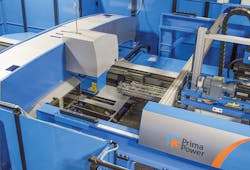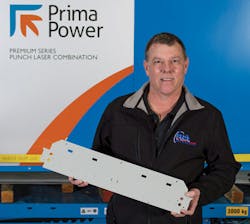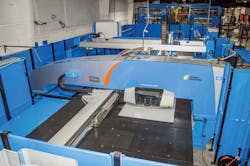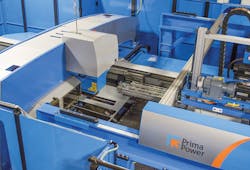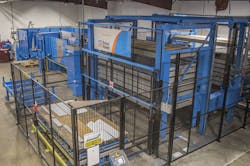Laser/punch combination meets product fabrication challenges
ROBERT J. KOLCZ
P & A Metal Fab (Clackamas, OR) has been a success story in the Pacific Northwest for decades. According to industry observers, the company has a winning business philosophy that is very straightforward: To provide everything a customer needs, charge a fair price, and deliver the job on time...every time. This dedication to service and quality helps to explain the deep loyalty among customers and employees, many of whom have worked for the company for over 20 years.
Phil Aronson, father of company president Dan Aronson, started P&A Metal Fab in 1978 out of a two-car garage a few blocks from its present location in Clackamas. "By 1991, the company grew into a fair-sized business," Dan Aronson explains. However, by that time, Phil Aronson was approaching retirement and later that year, he sold the company to the Kyoshin Giken Company (Tokyo, Japan). His son Dan stayed on in senior management and later in 2007, he and another Japanese entity, Tsuguaki Takahashi, purchased the company and formed a new trans-Pacific partnership that offers the partners greater reach and new opportunities.
Today, P & A Metal Fab has evolved into a contract manufacturing powerhouse with 90 employees, working in three facilities with over 75,000 sq. ft. of space. The company has also acquired an arsenal of laser cutting, fabricating, tube processing, welding, and powder coating to service its diverse customer base, including air handling equipment and industrial and consumer products such as computer furniture, all-terrain vehicles, and fitness equipment.
Staying up to date with leading manufacturing technology has also been a long-term company goal. When the company decided to replace an older model laser punch combination machine, Aronson put together a team of four employees to research the sheet metal fabrication market to find a replacement. After talking to several machine builders, industry experts, and other fabricators, P & A Metal Fab purchased a Prima Power LPe6f laser/punch combination machine, which was installed in August 2016 (FIGURE 1).
Combination machine capabilities and features
The machine combines servo-electric punching and fiber laser technology in a manufacturing solution that provides flexibility, speed, accuracy, and productivity to fabricate challenging products (FIGURE 2).
The inherent benefit of integrated punching and laser cutting is high versatility. The turret punch press can be used where it is easier or faster, and the laser where it is most flexible. Depending on the manufacturing task at hand, a user can choose the most productive manufacturing method. This amounts to flexibility for fulfilling varying requirements, cost efficiency, and competitiveness. The machine's fiber laser source has low-energy consumption and eliminates the need for laser gases.
The company required a machine that needs to be flexible and extremely fast for a quick response to production orders, often for very small quantities. To that end, the LPe6f laser/punch combination machine offers versatility and flexibility, combining multiple operations in one machine. This lean manufacturing style reduces cost per part, as parts will be made fast, easily, and accurately by one operator using only one operating and programming system. The following paragraphs describe the machine's features and capabilities:
High-performance punching. The machine's premium series turret punch press has properties such as automatic tool length measurement, optimization of stroke length, and easy adjustment of the punching stroke. These combine with others, adding up to faster setups and more ease of operation. The punching speed, tool rotation, and tool change time are improved. The punching stroke is numerically controlled, providing high-performance punching and excellent forming capabilities.
"The speed of the servo-electric punching is so much faster," Aronson says. "There is also less maintenance than the older hydraulic model. In addition, the servo-electric operation has lowered our power consumption by approximately one third. The forming station has also been a really good tool for us in that machine. It allows us to perform a great deal of upforming, extruding, and tapping, eliminating costly secondary operations."
Fiber laser cutting. The laser used in the system is a 4kW high-brilliance fiber laser (FIGURE 3). Cutting speed increases in proportion to power and a wide range of material can be cut, such as copper or brass. A significant reduction in operating cost is achieved because the laser has no maintenance requirements, no laser gas is needed, and energy consumption is far smaller when compared to other solutions.
Cutting with nitrogen. "Our largest customer is in the fitness equipment industry and mandates that if we cut with CO2, all traces of the laser oxide edge must be either mechanically or chemically removed," Aronson explains. "In order to avoid this costly secondary step, we switched to nitrogen and no longer have to be concerned with the laser oxide edge. To minimize the cost, we installed a nitrogen generator that has an 18-month payback."
Double-sided storage. A flexible material system with compact storage is a key module in automating the material flow (FIGURE 4). It makes different materials available at the working point quickly and practically, and can also serve as intermediate storage for ready components and as a buffer.
This combo storage system allows processing of components from a variety of materials, which can be changed, as programmed, automatically. The sheets are automatically transferred into machines and cells of the system. "The Combo FMS Double-Sided Storage provides us with 17 cassettes," Aronson explains. "We have 12 cassettes for raw material and five for parts."
Loading and stacking robot. P & A Metal Fab chose the portal-type LSR loading and stacking robot to be integrated with its combination machine (FIGURE 5). The LSR provides a reliable, fully automatic process, from loading to picking of parts and stacking them. Skeletons are unloaded with the unloading device. The operator is free for other tasks while machine productivity and utilization increases dramatically.
Increased productivity
"We have a project for a customer in the gaming industry, where we run four sets of parts on a sheet," Aronson concludes. "On our old punch/laser, the process took 45 minutes and the end product was non-sorted, micro-joint parts. On the Prima Power machine, the process takes 15 minutes...and the parts are sorted. I don't need to have an employee standing there sorting 100 sheets of parts that will take him a day or two to complete. We believe that we made the right decision in purchasing the LPe6f. This is the right tool for us. We are getting a great benefit from having the parts being sorted-that really reduces our secondary sorting labor."
ROBERT J. KOLCZ([email protected]) is director of marketing and corporate communication for Prima Power North America, Arlington Heights, IL; www.primapower.com.
